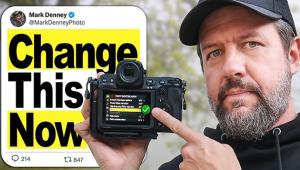Business Trends
Risky Business; Changing Business Models To Do What You Love To Do
As photo businesses go, David Alan Wolters (www.DavidAlanWolters.com) started out as many of our readers--a 12-year-old kid with a camera trying to find a place for himself in the world. Again, like many of us, Wolters went on to work on the high school yearbook as a photographer. Raised in the small town of Spring Lake, Michigan, a career as a commercial photographer did not seem imaginable to him, so he went to college to study engineering.

He got by until he decided to ask--what was he supposed to be doing with
his life? From his construction day job, Wolters started exploring the world
of photography again. After being accepted at Brooks Institute, he finally felt
he had found his place. The people around him finally were of "like mind"
with him in their interests, goals, and temperaments. After graduation, Wolters'
life changed again when he met (and later married) Terri Decaire.
Moving to Los Angeles, Wolters began by assisting local photographers (author's
note: always a good idea when planning a career in a competitive photography
market such as advertising photography). After a successful apprenticeship in
California, Wolters moved back to his hometown in Michigan to open his own studio
in 1992.

After 10 years in business and working with advertising and editorial clients
as diverse as Herman Miller, Avon, and Time magazine, Wolters found himself
at a crossroad. He decided to examine and reinvent his business to build a better
one. Wolters found the key to building a better business was to answer the question,
what does he really want to do as a photographer? He planned (and hoped) that
taking a strong direction would lead to the types of clients he wanted to work
with.
Shutterbug: Describe the "moment" it came to you--that
you wanted to take a strong direction and be proactive rather than reactive
as a business.
David Alan Wolters: I was a generalist who photographed products
and architecture and anything else that paid because that is what the photographers
I assisted in Los Angeles did. I never knew what to shoot for the portfolio
because it could be anything, so it was usually nothing. My book was made up
of work I did for clients and I rarely shot anything "just for me."
My wife joined me as my rep in 2001 and immediately pushed me to specialize
because she wanted to know what she was selling. It struck me like a ton of
bricks...that if my wife didn't know what I did, how would my clients?
For about a year before Terri joined me, I had been sneaking out of the studio
on nice days to find interesting people to photograph and Terri discovered those
images.

SB: Discovered? So they were not in your portfolio. What did
you do with the images and how did this change your direction?
DAW: It was clear when we laid out all my work that I was a
people photographer. That was it, the decision was made and I had to accept
the idea that every one of my clients was going to be alienated by our new business
model. I was also given the task of developing an entirely new portfolio of
images of people--ASAP. At first I emulated things I saw that I liked but
within a couple of months I started to see my own vision emerging. It was specializing
that made it possible to concentrate my effort and refine my vision.
















































